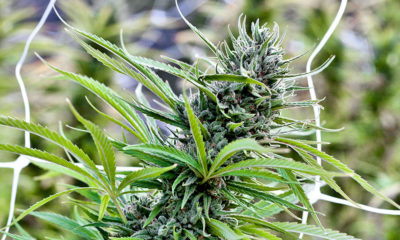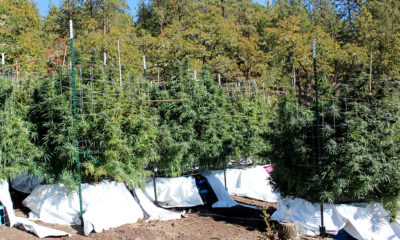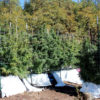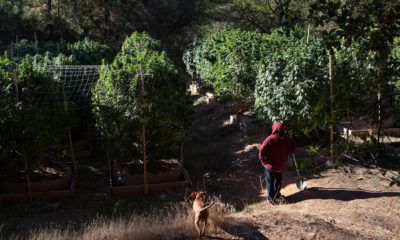
Cultivation
Marijuana Migrations
How pot growers are adapting to a changing climate.
By 2013, Jacob Sullivan had seen enough. Plagued by fickle growing conditions, consecutive scorching hot days, water right issues and topsoil problems, the farmer finally decided to pack it in and move 500 miles north, from Northern California to Oregon’s Willamette Valley.
“After six years of drought,” he said “it was time to admit that growing marijuana in that part of California had become unmanageable for me.”
Sullivan is part of a growing northern migration of California cannabis farmers leaving America’s weed-growing heartland for more stable growing conditions further north.
Pacific Northwest farmers, like cannabis cultivator and native Oregonian Toby Kavich, see rising numbers of California growers shuttling in to avail themselves to the relatively hospitable agricultural conditions of Southern Oregon.
“That’s not great news for us,” Kavich said. “It means a lot more competition in the marketplace.”
And of all the issues facing growers of any kind of plant in California, none were more critical than water access during the state’s drought.
Global Seeds of a Regional Issue
There’s no doubt that climate patterns around the globe are shifting, and the vast majority of experts agree it’s caused by human activity. Sea levels are rising — threatening low-lying areas like the Maldives, Bangladesh and Florida — coastlines are being redrawn and “storm surge” warnings are no longer an extraordinary event, they’re the new normal. Heat records are being shattered all over the world on a yearly basis and drought is prevalent.
According to a report by NASA’s Goddard Institute for Space Studies, atmospheric carbon dioxide levels are at their highest point in 650,000 years.
“Global temperatures have risen 1.7 (degrees Fahrenheit) since 1880,” the report read. “Nine of the 10 warmest years in the 134-year record-keeping period have all occurred since 2000, with the year 2015 ranking as the warmest on record.”
This global temperature change means a continued course toward uncertain and disruptive weather patterns, which means shifting growing conditions for farmers, including cannabis farmers.
In Europe, vineyards are sprouting up in parts of the once-chilly U.K. producing new wine varietals — some that rival the famed Champagne region of France 600 miles south.
California cannabis growers’ northern migration is just another index of the escalating climate problem.
“In this business, it often comes down to weather and access to water,” Sullivan said, kneeling beside a glorious, six-foot Cherry Kush plant. “Here [in Oregon], I’m no longer fighting the environment as much. I have access to water and to good soil. And that’s a godsend.”
Rooting For a Fight
Tim Blake is a man who knows about good, healthy soil. He’s been growing cannabis for over 40 years and he’s the founder of the internationally respected Emerald Cup – the largest outdoor, medicinal cannabis competition in the world — which takes place in Santa Rosa, California.
Blake sees the writing on the wall for many cannabis farmers in the state. He said key growing practices need to keep pace with the changing environment or more farms will go bust.
Many of the mountain properties of Mendocino (and even parts of the Emerald Triangle) were never meant for farming. And for years, outlaw farmers in Cali battled root rot and fungal issues due to poor irrigation in those largely clay areas.
“We don’t have a lot of real soil up in Northern California… a lot of it is clay, especially on these mountain slopes,” Blake said. “So now you have people growing in above-ground pots instead of building beds with healthy soil.”
But this adaptive strategy comes with an issue of its own. The trouble comes when ultra-hot weather raise surface temperatures, and by extension, the temperature of above-ground pots. The temperature of those pots can climbed climb as high as 120 degrees, baking away two-thirds of the precious water used for irrigation – water that is becoming less and less available to everyone in the state.
Blake said the Emerald Cup just added a new Regenerative Farm Award this year for that exact reason.
“That’s why we’re talking about regenerative farming… let’s get it out of the pots, get it back in the ground. You’ve got to mulch. You’ve got to have a real strong, living soil that doesn’t take as much water,” he said. “It’s a lot more challenging as a farmer – there are a lot more issues involved – but at the end of the day you not only work better with the environment and use a lot less water, but you make a better product, too.”
Blake added that every year at the cup, 10 percent of the entries are always better than the rest.
“Out of 500 entries, 50 are going to be phenomenal… you go talk to those 50 people, because usually they’re the same people every year, and you’ll find that they are growing in living soils and are doing it the right way,” he said. “They are composting their teas and getting them on the plants and they’re growing their product in a much healthier way – and you can see it in the products.”
It’s a good reminder that soil is active and alive, just like our wild environment. The management of a farm often means rolling up your sleeves and getting your hands deep in the dirt.
“You’ve got to make living soil happen,” Blake said.
Originally published in Issue 24 of Cannabis Now. LEARN MORE
TELL US, are you concerned about how climate change might effect cannabis production?




















